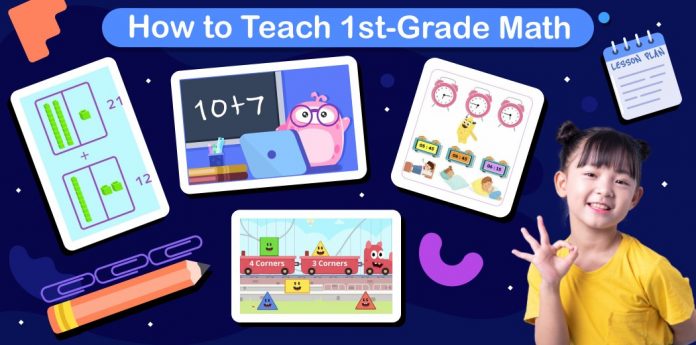Are you wondering how to teach 1st-grade math in engaging and effective ways? Or exploring what first graders learn in math? A quick glance at first-grade math goals might seem like they’re just an extension of kindergarten—counting all the way up to 120, more addition and subtraction, extending place value understanding, and diving deeper into shapes and measurement skills. But this is important! Building on foundational knowledge is a core principle of scaffolding.
Math & ELA | PreK To Grade 5
Kids see fun.
You see real learning outcomes.
Watch your kids fall in love with math & reading through our scientifically designed curriculum.
Parents, try for free Teachers, use for free
Knowledge gaps in early grades (6-7 year old kids) are easy for parents and teachers to address. So, if a child needs to catch up on a few kindergarten concepts, that’s fine! First grade offers an excellent opportunity to prevent these math gaps from snowballing into bigger challenges in future grades. The idea is to create an amazing classroom environment every single day that encourages kids to learn more!
This detailed guide on teaching first-grade math covers fundamental first-grade math skills, teaching strategies, tips to tackle common challenges, and lots of resources, including 1st-grade math lesson plans, 1st-grade math games, 1st-grade math worksheets, teaching tools, and more—all completely FREE for teachers and schools to use!
How to Teach 1st Grade Math
As you prepare to teach 1st grade math, you might feel overwhelmed by the rigmarole of lesson planning, classroom setup, and ensuring each student is ready to grasp new concepts. The answer to “how to teach 1st grade math” is not straightforward! There’s no perfect method. But yes—teacher-directed learning and teacher-guided activities always work like magic. The key is to keep things moving, keep adapting, and try different strategies to see what resonates with your students at the moment. That’s what we’ll learn together! Ready to explore 1st-grade math topics? Let’s dive in!
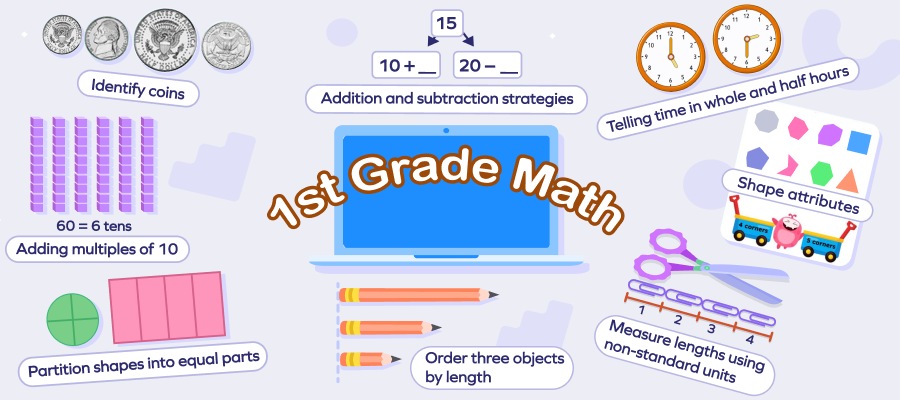
1. Numbers and Counting
| Counting, Reading, and Writing Numbers in 1st Grade | |
|---|---|
| Extend the counting sequence. | • Count up to 120, starting from any number below 120. • Learn to read and write numbers up to 120. |
Consider these tips before you teach counting to 1st graders:
- Make an anchor chart in the classroom that shows numbers in different forms (number words, base-10 blocks, numeral, place value breakdown, etc.). Also, a visual display of a hundreds chart (extended to 120) at home is a great idea!
- Emphasize the correct way to read and say these numbers (without inserting “and” after 100). For example, 103 is read as “one hundred three.” It’s not “one hundred and three.” Remember, those little classroom conversations stick with kids! They’ll be saying, “Teacher told us so!” in no time. Use a bulletin board to show the WRONG and RIGHT way. Visual reminders make a lasting impact!
- Parents can establish math learning games and materials that create a creative learning space for kids. One of the easiest games to play daily is counting the mess. Your child can help you clean up their educational toys after playtime, but it is another playtime! Guess the number of toys and other things to be kept away and count them as you clean.
- Encourage practice with counting from different starting points. Consider these fun educational games that playfully address this skill:
Play and count up to 120!!!
In some states, kids learn to count up to 150, but let’s not go into those details. What truly matters is the learning journey itself! Whether your child is already counting to 100 or finding 80 a stretch, support their progress. For those who’ve mastered these milestones, encourage them to lend a hand to their peers! With practice, counting up to higher numbers will become second nature!
Bonus Tip: Consider using the Counting Numbers Teaching Tool for struggling students. Drag objects and count them on-screen, making learning fun and visual. This tool is also perfect for parents who want to keep the learning going at home! Let’s help them catch up. A little playful practice is all it takes!
Related Reading: How to Teach Number Sense
2. Place Value (Ones and Tens)
| Place Value in 1st Grade | |
|---|---|
| Understand place value concepts. | Understand that two-digit numbers represent amounts of tens and ones. • The number 10 is seen as a bundle of ten ones, referred to as a “ten.” • Numbers 11-19 consist of a group of 10 ones and additional ones ranging from 1 to 9. • Numbers like 10, 20, 30, up to 90 have zero ones. |
| • Compare two-digit numbers by evaluating the tens and ones digits. • Use math symbols >, =, and < to record which number is greater, equal, or lesser. | |
There are multiple concepts, but can you identify the highlight? The number 10! Let’s ensure kids learn the magic of 10 through creative and upbeat lessons.
- Use ten frames to solidify the concept of 10. Ensure that students fully understand how to compose and decompose 10.
- Kids often stumble during the transition to decade numbers (for instance, moving from 29 to 30). They might say “twenty-ten” instead of “thirty.” Help them say both the standard and expanded forms of numbers out loud. For instance, teach them to see 47 as “4 tens and 7 ones” and “forty-seven.” Use the CLAPPING method to signal the transition from one decade to another.
Are you looking to incorporate these crucial insights into your lesson plans? Don’t worry! Our Number Sense Lesson Plans for 1st Grade include everything from proper instructional flow and time stamps to tips for addressing misconceptions, plus engaging activities to keep students motivated—ready for you to use.
Teach 2-digit place value effortlessly!
Let’s not forget that mistakes help us all learn, so remember these things to watch out for when teaching place value to 1st graders:
| Common challenges | Here’s a quick tip! |
|---|---|
| Decomposing teen numbers(This is a skill gap from kindergarten.) | Have students count objects between 10 and 20. Show how these can be grouped into tens, with any leftovers clearly visible. Assign the Decomposing Teen Numbers Game during independent work hours. |
| Comparing 2-digit numbers can be overwhelming for kids (not understanding which digits to compare first) | Incorporate Compare 2-Digit Numbers Games for 1st Graders during math centers. Encourage students to play independently. Guide them when they are stuck. |
If you are wondering how to teach place value skills effectively, remember this: learning place value is a detailed, ongoing journey. It’s crucial to have well-aligned resources at your disposal. Our interactive games are designed to help children explore these essential place value concepts in a fun and engaging way, supporting their learning journey every step of the way.
Enjoy place-value play!
Additionally, use fun printables or focused worksheet bundles for place-value practice drills at home or in class.
Practice ones and tens like a pro!
3. Addition and Subtraction
| Addition and Subtraction in 1st Grade | |
|---|---|
| Apply place value concepts and properties of operations to add or subtract. | • Add within 100 (i) adding two-digit and one-digit numbers (ii) adding two-digit numbers with multiples of 10 • Mentally find 10 more or 10 less than a two-digit number. • Subtract multiples of 10 in the range 10-90 (positive or zero differences). |
| Represent and solve addition and subtraction word problems (within 20) | • Adding to, taking from, putting together, taking apart, and comparing with unknowns in all positions • Addition of three whole numbers |
| Learn and apply properties of operations | • Commutative and associative properties • Understand subtraction as a problem with a missing addend. |
| Add and subtract within 20. | • Relate counting to addition and subtraction. • Strategies: counting on, making ten, decomposing a number leading to a ten, using the relationship between addition and subtraction, and creating equivalent easy expressions. |
| Work with addition and subtraction equations. | • Understand the use of the equal sign (=). Determine if addition and subtraction equations are true or false. • Determine the unknown whole number in an addition or subtraction equation. |
NOTE: Are you wondering if it’s the right time to introduce regrouping? You are not alone. Standards are adapted differently from state to state. While the introduction of regrouping skills in 1st grade is debated (and may feel a little early), it’s important to consider the readiness and progress of students in your class. Experts do suggest that teachers can go ahead and introduce it sooner rather than waiting till 4th grade.
Consider these points before you teach addition and subtraction to 1st graders:
- Focus more on the “counting on” strategy for addition (find the total) and subtraction (find the unknown addend). Support it with visual aids. Help kids see the consistent pattern of zeros when you add or subtract 10.
- Use a number line to show how to take jumps and add three whole numbers.
- Discuss 2-digit addition and subtraction problems in both horizontal and vertical forms.
- Teach addition and subtraction word problems that involve unknowns in various positions. Also, introduce the new type—”compare” problems (finding “how many more” or “how many less.”)
Teaching can be overwhelming with so much to cover. To simplify, we’ve created a collection of Addition Lesson Plans for 1st Grade and Subtraction Lesson Plans for 1st Grade. These plans are curriculum-aligned, well-organized, and completely free for teachers!
Enjoy teaching 2-digit addition and subtraction!
Bonus Tip: Consider using this online math facts practice tool and these free addition games in math blocks. Choose operators, set the number range, select up to 100 questions, and let kids practice daily!
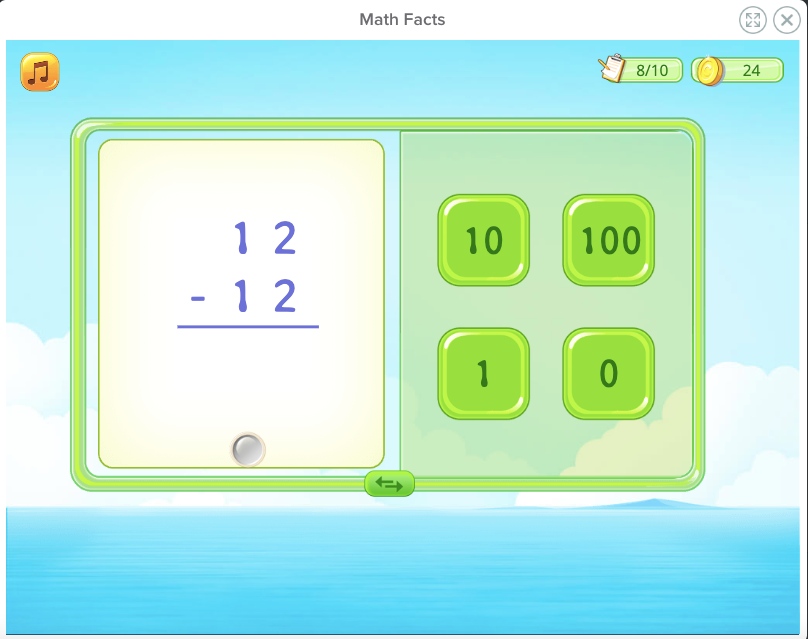
| Common challenges | Here’s a quick tip! |
|---|---|
| The language of the word problems can be challenging for kids to understand. | Teach them how to break down the problem into manageable steps. Plan a mini-lesson just for teaching word problems, or make a class routine to discuss a word problem daily! |
| Relying solely on keywords like “left” or “total” to decide the operation | Guided practice sessions with a variety of problems can help. Consider using Addition Word Problems Games for 1st Grade and Subtraction Word Problems Games for 1st Grade. Start with 2 or 3 problems a day! |
| Applying the commutative property to subtraction | Contrast it with addition, where the property does work. Start with addition properties games for 1st grade. Use clear examples and visual aids (number lines) to show how changing the order of numbers in subtraction changes the result. |
Having engaging resources that match your classroom instruction is a dream for every teacher. That’s exactly how our addition and subtraction games for 1st grade are designed! Give them a try and see how they make learning 2-digit addition and subtraction more enjoyable for your students!
Enjoy adding ones and tens!
For extra support and reinforcement, consider printables that can be used at home or in class! Group students based on skill level and pick worksheets targeting required concepts.
Master the skill!
4. Length Measurement
| Measurement in 1st Grade | |
|---|---|
| Measure lengths using indirect methods and by repeating smaller units until you cover the entire length of the object. | • Order three objects by length. • Compare the lengths of two objects indirectly by using a third object. • Measure lengths with non-standard units. • Express the length of an object in non-standard length units (as a whole number). • Measure by laying a shorter object (the length unit) end to end multiple times, without gaps or overlaps (iterating length units). |
Remember how in kindergarten, the kids compared two objects directly? Now we’re stepping it up to ordering three objects by length in first grade. This shift is a big deal in their learning journey, and it calls for some engaging, hands-on measurement activities.
- As you prep your lessons, think about including interactive tasks where the kids can get hands-on with objects—let them touch, move, and compare. It’s a fun and effective way to solidify their understanding of measurement and ordering.
- Focus on teaching how to measure length accurately from one end of an object to the other and justify their measurements based on their starting and ending points.
- Teach the transitive property of length using three objects. If a < b and b < c, then a < c. For example, if a crayon is shorter than a pencil, and a pencil is shorter than a pen, then the crayon is shorter than the pen.
Mastery comes best through hands-on activities and not just textbook drills. That’s exactly how our Length Games for 1st Graders support kids!
Game on! Measure lengths like a pro!
NOTE: Objects sometimes do not align perfectly with whole units. Teach kids how to choose the number closest to the actual measurement (for example, saying the pen is around 5 cm long).
Related Reading: What Are Transitive Relations?
5. Organizing and Interpreting Data
| Sorting Objects in 1st Grade | |
|---|---|
| Represent and interpret data. | Collect and organize data into up to three groups, then analyze it by asking and answering questions about • the total number of data points, • the number in each group, and • the differences between the groups. |
In grade 1, kids learn to use charts and graphs to organize and represent information about things that interest them (up to 20 data points)! This can be done individually or as a group, building teamwork skills. Consider these tips before teaching data handling to 1st graders:
- Teach students to gather and represent data in charts, analyzing it to find totals and category comparisons (majorities within categories, and compare quantities to identify which category has the most or least).
- Introduce data collection using tally charts. Encourage students to categorize data into three groups, count tally marks in each group, and compare totals. Foster critical thinking by asking questions about the data collected.
- Teach them how to use addition, subtraction, and comparative language (“more than,” “less than”) to understand the information in the chart. (This will prepare them for drawing data graphs in 2nd and 3rd grade.)
This area requires a bit more prep time since it often involves creating visuals or collecting tangible items. What if you could simplify this process with fun games that captivate and educate? Our interactive games will help you save time!
Sort, count, compare, and PLAY!
For a refreshing change in kids’ practice routines, try our 1st-grade data-handling worksheets! They provide engaging sorting activities, making learning continuous and enjoyable outside the classroom.
Bonus Tip: Maximize teaching efficiency with our tally tool! Easily add, remove, and count tally marks up to 100. Perfect for interactive classroom demonstrations!
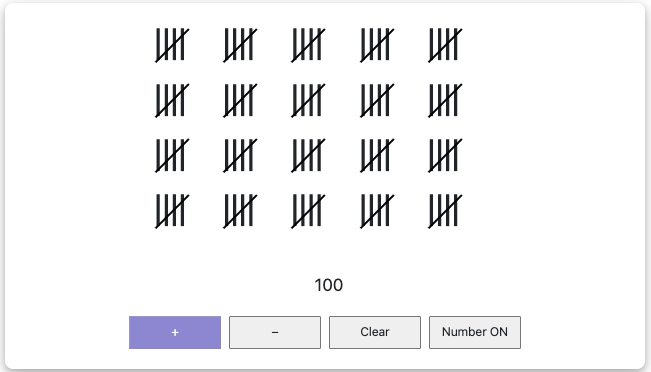
6. Telling Time
| Time in 1st Grade | |
|---|---|
| Tell and write time. | Tell and write time in hours and half hours using analog and digital clocks. |
This is a life skill! Understand that the concept of time itself can be abstract for 1st graders. So, a proper introduction to the analog and digital clocks is necessary. Here are some helpful tips for your lesson preparation:
- Help students recognize and differentiate between the hour and minute hands on a clock. Use visuals or teaching tools that allow you to drag the clock hands. Focus on essential time-telling vocabulary such as “hour,” “minute,” “thirty,” and “half past.”
This free Telling Time Teaching Tool is perfect for classroom demonstrations. It features both analog and digital clocks.
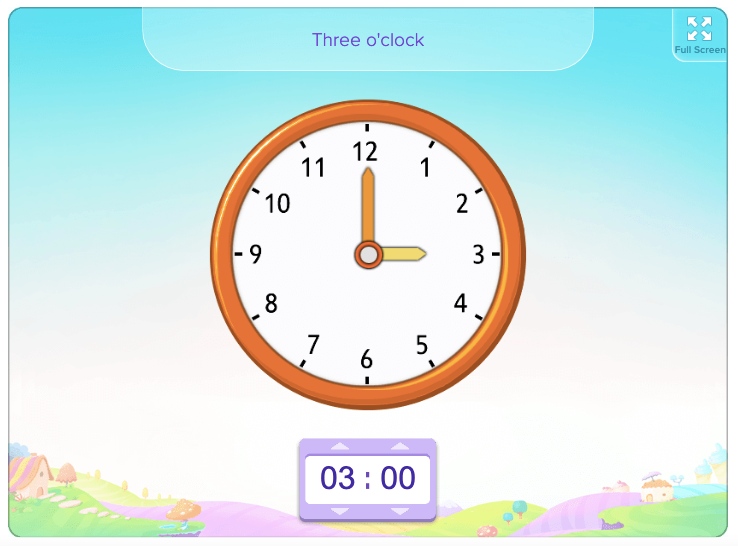
- Encourage students to practice setting the time on analog and digital clocks and draw clock hands to represent specific times. The primary assessment goal is for kids to understand time concepts rather than perfect clock-hand drawings.
- Math Center Idea: Build a life-size analog clock using classroom supplies like a rope or hula-hoop for the clock face and pens, pencils, or sticks for clock hands. Involve students in the assembly process to boost ownership and excitement. Use this interactive tool for fun group activities like setting time, identifying clock hands, or reading time! Parents, this is perfect for home learning, too!
Sometimes, TIME-CRUNCH itself is a real struggle for teachers, especially when planning and creating comprehensive lessons. We’ve all been there! Consider using our ready-to-use lesson plans for first grade—crucial time concepts are systematically packaged in fun lessons. Teach the tick-tock of both analog and digital clocks with ease!
It’s time to teach time!
Also, considering this is a new territory for 1st graders, they may face particular challenges. Let’s understand.
| Common challenges | Here’s a quick tip! |
|---|---|
| Students often struggle to grasp that 30 minutes is “halfway” through an hour (it may also be tricky for students because these units aren’t directly visible on a clock face.) | Encourage students to visualize or draw increments of tens. Make the idea more concrete and manageable. • Two 30s = 60 minutes. • 30 minutes = 3 tens • 1 hour = 6 tens Use time in half-hour games for 1st grade to supplement this learning further. |
| Identifying positions of clock hands (confusing clock hands) | This needs focused and repeated practice. Try using Identify the Positions of Minute and Hour Hands Worksheets as homework. |
Hey teachers! As we dive into various strategies on how to teach telling time, let’s remember that mastery won’t come overnight. Telling time is a life skill that develops gradually, improved by daily curiosity and playful practice.
Encourage your students to explore time throughout their day. Pose questions like, “Lunch is coming up soon; is the short-hand getting close to 12?” Linking the concept to their daily routines can make a big difference. Utilizing interactive games and activities is a fantastic way to keep them engaged and make learning fun!
Time's ticking! Start playing!
Fact: Consistent practice leads to confident clock readers! Let kids practice telling time at home or during math blocks with our fun worksheets.
Learn to tell time like a pro!
7. Introducing Money
| Money in 1st Grade | |
|---|---|
| Build an understanding of money. | • Identify quarters, dimes, and nickels and relate their values to pennies (cents). |
Grade 1 is all about knowing quarters, dimes, and nickels and their values in both cents and number of pennies (e.g., a dime is 10 cents or 10 pennies). First graders are still learning basic addition and subtraction. So, don’t worry about adding or subtracting groups of coins yet. Give kids ample opportunities to get familiar with coins and bills.
A question: How did you learn about money concepts? Or how did you master them? Do you remember? Your memory might be fuzzy because, chances are, practical experiences played a great role in your learning!
The point? Hands-on learning is powerful! Recreate that magic in the classroom. Plan pretend shops or markets for kids. You will see they already have more money skills than we give them credit for (perhaps gathered through everyday observations)!
Keeping all this in mind, we have prepared lesson plans that are perfect for classroom smart boards or interactive displays! Use them and watch how your ideas and teaching magic come to life.
Introduce coins and bills with fun lessons!
Help kids solidify their understanding of various coins and bills with our engaging games. Each game is designed to target specific skills in a fun, simple format that has a powerful educational impact!
Play with pennies, nickels, and dimes!
Bonus Tip: Try the Identify and Count Coins Teaching Tool. It’s perfect for quick demos in class or at home! Just a click will display both sides of the coin, along with their names and values.
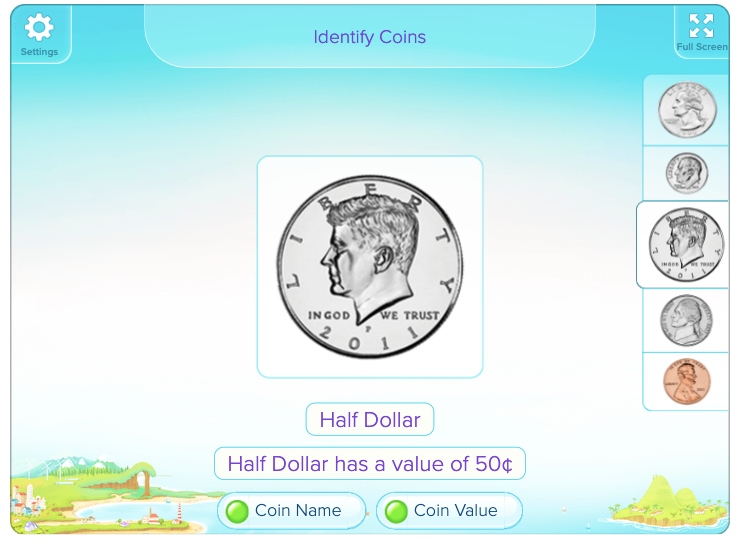
8. 2D and 3D Shapes, Shape Attributes, and Composite Shapes
| Geometry in 1st Grade | |
|---|---|
| Reason with shapes and their attributes. | • Differentiate between defining attributes (e.g., triangles are closed shapes with three sides, or hexagons have six straight sides) and non-defining attributes (e.g., color, orientation, size). • Create and draw shapes based on their essential attributes. • Compose 2D shapes or 3D shapes to form a composite shape. Then, use this composite shape to create new shapes. • Partition circles and rectangles into halves and quarters. • Understand that the whole shape can be described as two halves or four quarters. |
Teachers, this is a heads-up: The trapezoid has two common definitions. Check your state’s curriculum standards to avoid confusion.
- Exclusive Definition: A trapezoid has exactly one pair of parallel sides.
- Inclusive Definition: A trapezoid has at least one pair of parallel sides. (A parallelogram would also be considered a trapezoid.)
There’s a lot to consider and a lot to teach here. Let’s understand how we can simplify classroom instruction.
- Show kids how color or orientation does not define a shape, but sides, lengths, and corners do. These games can help you convey this idea:
Play and understand shapes beyond appearance!
Print out this worksheet: Sort 2D Shapes Using Venn Diagram Worksheet. It playfully targets this concept.
- Similarly, use real mathematical terms for describing 3D shapes, such as faces, edges, vertices, or curved surfaces! Help kids see how 2D shapes form faces of 3D shapes. Try these games for visual learning:
Playtime with faces, edges, and vertices!
- Teach kids how to combine shapes to make bigger shapes and which shapes make up a bigger, already-made shape. For example, show them how aligning two squares side by side forms a rectangle! Print out our “Create Shapes from Other Shapes Worksheets” worksheets and use them as a math center activity. The best part? It involves coloring!
- You can also conduct an “early-finisher-challenge” with the following worksheets. Kids love such fast-paced activities!
From flat to fantastic! Craft shapes into creations!
- Partitioning shapes can be tricky to teach to 6—to 7-year-olds. Explore our dedicated resources: games for partitioning shapes into equal parts!
Bonus Tips: We know teachers and parents can only use some resources simultaneously! These bonus tips are like extra tools you can keep in your toolbox. After all, the more resources you have, the better equipped you are to teach elementary math!
- 2D Shapes Teaching Tool:
- You can help kids visualize triangles and quadrilaterals.
- Help them count the number of angles and sides.
- Display or hide shape attributes as needed.
- 3D Shapes Teaching Tool:
Related Reading: Best Geometry Apps for Kids
Preparing 1st Graders for 2nd Grade Math
In grade 1, as you must have observed, measurement and geometry are introduced alongside numbers and operations. The instructional focus is addition, subtraction, and measurement with whole numbers. Students are also expected to be fluent in adding and subtracting within 10 by the end of grade one.
But what should first graders know before they enter grade 2? Let’s summarize the math objectives for 1st grade that will help smooth the transition to 2nd grade.
Ready for 2nd grade? Here’s your first-grade math concepts checklist:
1. Numbers and Place Value
▢ Counting up to 120
▢ Comparing, reading, and writing numbers up to 100
▢ Understand teen numbers 11-19 as ten and some ones
2. Addition and Subtraction
▢ Add and subtract within 20 (Demonstrate fluency within 10)
▢ Solve word problems (add-to, take-from, put-together, take-apart, compare)
▢ Apply properties of addition (associative and commutative)
▢ Add within 100, subtract multiples of 10
▢ Mentally find 10 more or 10 less without counting
▢ Understand addition and subtraction equations
3. Measurement of Lengths
▢ Order three objects by length
▢ Compare the lengths of two objects indirectly by using a third object
▢ Indirectly compare lengths using a third object
Related Reading: How to Teach 2nd Grade Math
Conclusion
So, here we are! Teaching 1st-grade math can feel like balancing on a seesaw. On one side, you’re helping them catch up on anything they might have missed in kindergarten math. On the other hand, you’re already preparing them for 2nd-grade skills. With some planning and these handy tips and resources, we can ensure that 1st graders approach math with confidence and a sense of wonder! Onwards and upwards!
Frequently Asked Questions (FAQs)
How can I help my first-grader with math at home?
- Playful Learning: Sing math songs together, count objects during errands, or bake cookies and measure ingredients! Everyday activities become fun math lessons.
- Hands-on Fun: Use buttons, blocks, or cereal to practice counting and sorting. Let them write numbers in sand or trace them on paper. Physical interaction helps with memory.
- Short & Sweet: Aim for 10-15 minutes of focused practice, filled with encouragement and celebrating their progress!
How can I differentiate math instruction for a wide range of abilities in first grade?
Differentiating math instruction means tailoring teaching to meet the diverse needs of your students. Here are some strategies:
- Tiered Assignments: Offer different levels of challenge within the same task.
- Choice Boards: Provide students with options to choose activities based on their interests and abilities.
- Learning Centers: Create centers with varying levels of difficulty.
- Individualized Support: Offer one-on-one or small group support for struggling students.
- Open-Ended Tasks: Provide problems with multiple solutions to challenge advanced learners.
How can I assess first-grade math understanding in a formative way?
Observe students, conduct conferences, use exit tickets, math journals, and checklists. Analyze student work. Use digital games for insights.

















